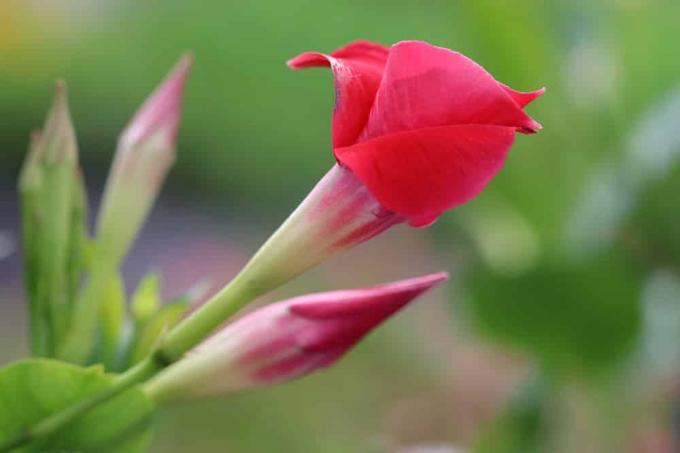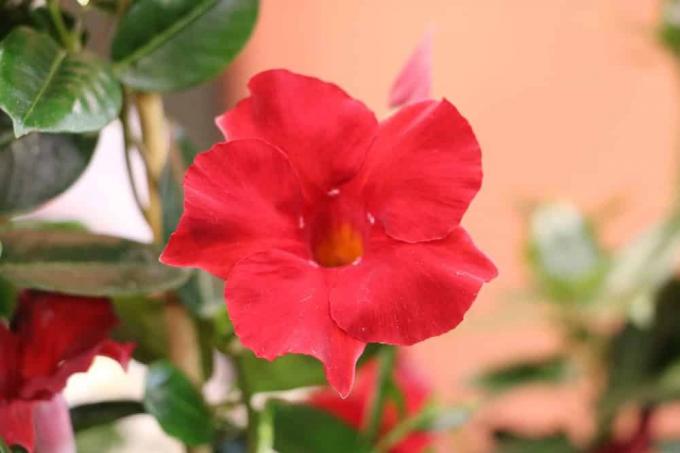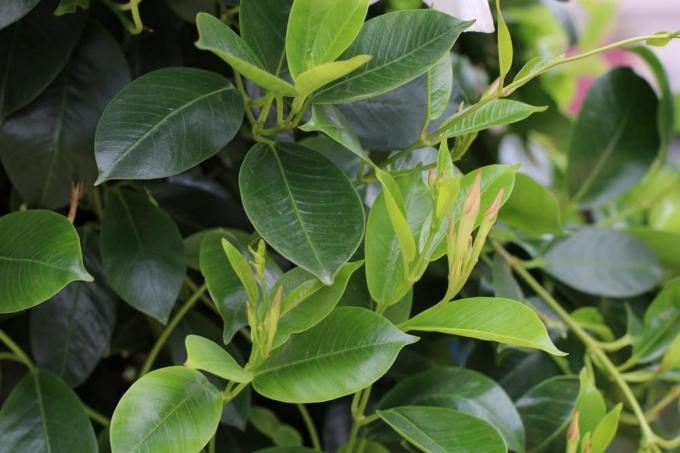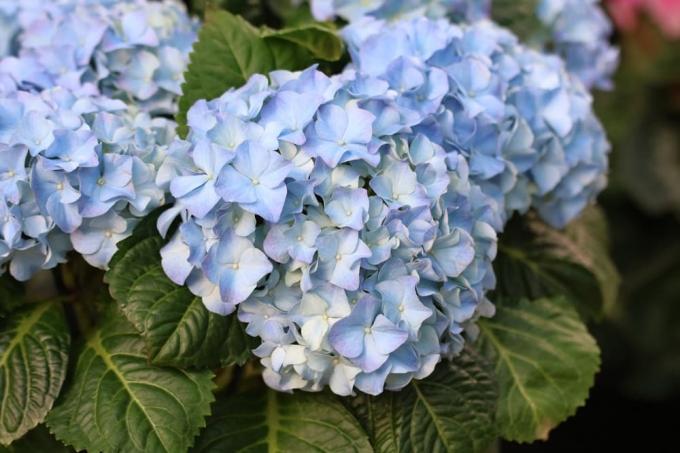

Table of contents
- Location
- Pour
- Fertilize
- substrate
- repot
- Step-by-step instructions
- Cut
- multiply
- Cut and root cuttings
- hibernate
- diseases and pests
- spider mites
- aphids
The Dipladenia 'Sundaville red' is a hybrid of the container plant Dipladenia sanderi (Mandevilla sanderi). This climbing plant, originally from the South American tropics, enchants with its unusual abundance of flowers. 'Sundaville red' tirelessly forms bright red, trumpet-shaped flowers. In summer, the not frost-hardy plant feels very comfortable on the balcony or terrace, but can also be kept indoors all year round.
Location
The ideal spot for the Dipladenia 'Sundaville red' is warm and sunny, allowing you to plant the plant during the particularly light-intensive periods Should be shaded during the summer months at midday - you don't like too much sun either, so that burns can quickly develop on the leaves form. During the growing season, it is best to place the 'Sundaville red' directly in front of a window, for example one that faces south or west. The location does not have to be in full sun, but bright and warm. Temperatures between 20 and 25 °C are optimal – if it is cooler, the plant often stops flowering. Also make sure that the chosen place is not directly draughty, but airy. Stagnant, warm air is one of the most common causes of spider mite infestation.
Ideal site conditions at a glance:
- bright and sunny
- not necessarily full sun
- shade in the bright midday sun
- warm at temperatures between 20 and 25 °C
- airy but not drafty
- if possible directly in front of a window
The site conditions mentioned apply only to the growing season (approximately between March and October), in winter the 'Sundaville red' definitely needs a rest phase and therefore a cooler one Location.
Pour

How much water the 'Sundaville red' actually needs depends on the season. During the summer months, when the sun shines intensely and it is warm or even hot, you should water the plant daily. To do this, it is best to place the pot on a saucer or in a planter, into which you pour a little water in the morning - but the Dipladenia must not stand wet! During the course of the day, the plant gets the water it needs through the roots, and a large part also evaporates. If it is cooler in summer or in spring and autumn, you need to water much less frequently - on the one hand, the water requirement is not as high, on the other hand, less moisture evaporates.
Tip:
With a simple plant moisture meter (put into the potting soil) you can check whether the 'Sundaville red' actually needs to be watered. The device reliably displays the moisture level of the substrate. The Dipladenia should not dry out, but should not be too damp to avoid waterlogging.
Fertilize
The long and lush flowering phase costs the Dipladenia 'Sundaville red' a lot of energy. For this reason you should provide them with a good flowering plant fertilizer every one to two weeks between May and August. Liquid fertilizers, which you simply administer together with the irrigation water, are ideal. How often the plant actually needs to be fertilized depends on how often you need to water it - the Dipladenia needs it right now no water (e.g. because the summer is rather cool and therefore little water evaporates), then you don’t have to fertilize them as often. In a warm summer, however, weekly fertilization is beneficial.
Tip:
The 'Sundaville red' blooms particularly lavishly if you only water it a little to moderately in the summer months, but fertilize it weekly.
substrate
If you want to buy ready-made potting soil, commercially available geranium soil is also very suitable for the Dipladenia 'Sundaville red'. Otherwise, any humus-rich, loose soil for pots or balconies serves the same purpose. If you use pre-fertilized soil, you don't need to cover the first four to six weeks after potting fertilize - the nutrients already present in the substrate are perfect for this first period sufficient.
Good drainage is just as important as the right substrate to prevent waterlogging. Choose a plant pot with drainage holes in the bottom. As the bottom layer, put some broken pottery and / or some expanded clay in the pot - only then fill the substrate. The plant pot also stands on a saucer or a planter from which you regularly remove excess water.
repot

Like any other container plant, you also have to repot the Dipladenia 'Sundaville red' regularly. You should take this measure about every two to three years - it is due when the first fine roots are already growing out of the drainage holes on the bottom of the pot and the pot is thus rooted is. You don't necessarily have to put the plant in a new, larger pot. Whether this is actually necessary depends on the size of the dipladenia and how much you prune it.
If the 'Sundaville red' is to grow, it needs a larger container when repotting. In this case, choose one that is one size larger than the previous one. Under no circumstances should the pot be too big for the plant, otherwise it will invest more of its energy in root growth and less in the development of flowers. Spring is the best time to repot, especially April.
Step-by-step instructions
– Repot Dipladenia ‘Sundaville red’ –
- Get the plant out of the old pot
- if possible, do not damage / tear off any roots
- Carefully loosen the root ball with your fingers
- Gently shake out excess old soil
- Check roots for diseases/injuries
- Carefully cut back diseased/injured roots
- use sharp, clean scissors for this
- clean old pot / wash with hot water (if reused)
- or use a new pot
- Fill in the drainage layer: approx. 10 percent of the pot volume
- Shards of pottery over drainage holes, expanded clay
- Fill half of the substrate
- Hold the plant with the root ball in the pot
- fill in soil
- Press down the filled soil around the plant with your fingers
- close any cavities: tap the pot gently on the table several times
- If necessary, top up with soil and press down
- water the plant

Since the Dipladenia 'Sundaville red' is a climbing plant, you should also use a climbing aid or climbing aid. install a trellis. Various trellises or trellis towers are suitable for this, which can simply be placed in the planter. Which material you choose is entirely up to your taste. Metal and plastic are particularly durable and easy to care for, but climbing aids made of wood or bamboo also serve their purpose.
Tip:
This climbing aid is particularly simple (but effective): Put several thin bamboo sticks in a circle around the Dipladenia 'Sundaville red' in the ground and connect the ends tent-like above the Plant. Attach the tendrils to the individual struts using orchid clips so that the plant can then climb them independently.
Cut
The best time for a pruning is when you want to repot the Dipladenia 'Sundaville red'. This measure is necessary anyway in the case of injured roots so that the remaining ones can continue to provide the plant with sufficient care. However, do not cut any new shoots, because like so many summer flowering plants, 'Sundaville red' only flowers on this year's shoots. However, older shoots can be shortened without any problems, whereby you can remove or trim overly long side shoots in particular. should cut back. The plant can also be cut back in height - if you don't do this, the Dipladenia can grow up to three meters high. If the plant is too big for the winter quarters, you can also cut it back in autumn, just before hibernation.
Tip:
Since the Dipladenia 'Sundaville red' belongs to the dog milk family, its milky sap is poisonous and can be harmful to sensitive people Skin rashes and swollen and irritated mucous membranes (if the plant sap gets in contact with the eyes, for example). and ä. device). For this reason, you should always wear gloves when cutting the plant and avoid touching your face with them.
multiply
Since the Dipladenia 'Sundaville red' is a breed that is protected under commercial law, it is actually not allowed to propagate it yourself. For your own use, however, you can propagate the plant from cuttings, for example to grow more specimens or because you cannot overwinter the large Dipladenia.
Cut and root cuttings
– step-by-step guide-
- best time: May or June
- Cut head cuttings: upper shoot tip with a pair of leaves
- Put the cuttings individually in pots with potting soil
- alternatively: mixture of sand and unfertilized potting soil
- Cut off the PET bottle and put it over the cutting
- Always keep the substrate slightly moist (not wet!)
- put in a warm and bright place (no direct sun!)
- ideal temperatures: between 23 and 26 °C
- air daily
You can tell after a few weeks whether you have successfully rooted the Dipladenia 'Sundaville red': if the small cuttings sprout and forms new shoots and leaves, so you can remove the protective plastic cover and place the plant in a larger container with suitable potting soil implement.
hibernate
During the cold season, the Dipladenia 'Sundaville red' absolutely needs a resting phase and must therefore not hibernate in the warm living room. The plant overwinters between November and February / March in a bright and cool place, with temperatures between 10 and 15 °C being ideal. However, these conditions cannot always be met, so you can also bring the Dipladenia cooler over the winter at around five degrees Celsius. In this case, however, the plant will probably shed all its leaves, but will sprout again in the spring. On the other hand, if you overwinter the plant in a warm apartment, the leaves will turn yellow and the next year there may be no flowering due to the lack of a resting phase. Caring for Dipladenia 'Sundaville red' in winter:
- do not fertilize
- pour little
- bright, cool location at 10 to 15 °C

In spring you should slowly bring the plant out of hibernation by gradually getting it used to higher temperatures and watering it more. The Dipladenia also has to adjust to the brighter location by the window: place it initially only by the hour at their traditional summer location, preferably in the morning or afternoon. Yellow leaves, withered shoots and lack of light during the winter months You should remove grown horny shoots, also cut back the plant and, if necessary repot. From May the plant is fertilized again.
diseases and pests
The leaves of the Dipladenia 'Sundaville red' are covered with a waxy layer that is supposed to protect the plant from pathogens such as fungi or bacteria. In fact, the plant is quite insensitive to various diseases, but can still - like any living being - be infected with pathogens or pests. If this happens, there are usually care mistakes behind it or the Dipladenia does not feel comfortable in its location. In addition to actually combating the disease or of the pest infestation, you should also look for a cause for the weakening - and thus arm the plant against a new infection.
spider mites
Spider mites, which suck leaf juice, are among the most common pests on houseplants and don't stop at Dipladenia 'Sundaville red'. The tiny animals appear primarily in very warm locations with "stagnant air". They are usually only discovered very late. Spider mites can be controlled with insecticides, but these toxic chemicals are unsuitable for indoor use. Thoroughly shower the infested Dipladenia 'Sundaville red', wipe the leaves and shoots with a damp cloth and severely cut back infested parts of the plant. Place the plant in a more suitable, airy location and ensure high humidity.
aphids
Aphids can also be easily combated by showering the infested plant several times with a warm shower jet. Non-toxic agents based on oil or curd soap (soft soap) also help here. You can easily make the latter yourself: Dissolve a tablespoon of soft soap in a liter of warm water and wipe the leaves of the Dipladenia - especially the undersides! - several times at intervals of several days.
 garden editorial
garden editorial I write about everything that interests me in my garden.
Learn more about potted plants

Spider Flower, Cleome hassleriana: Care Instructions
Spider flowers get their name from their spider-like appearance. Many hobby gardeners shy away from cultivating the beautiful exotic species. When it comes to maintenance, there are just a few things to keep in mind.

How do I care for a gentian tree? Lycianthes rantonnetii
A gentian tree can be a decorative enrichment both on the balcony and in the garden. For the culture, however, some criteria must be observed. This includes, among other things, the high nutrient content that is required for flowering.

Overwinter pampas grass | 16 tips for winterizing
Pampas grass is a popular ornamental plant in the garden or in tubs, which can be attractively integrated into a wide variety of garden ideas thanks to its decorative fronds. They are considered hardy, but need suitable winter protection in Central Europe due to possible moisture damage.

Leadwort, plumbago: care from A to Z
Leadwort (Plumbago) hides one of the most attractive potted plants of all. The magnificent shrub impresses above all with its blue flowers, which it produces from May to autumn, transforming terraces and balconies into a luminous oasis.

Hydrangeas, rhododendrons and hibiscus smoke | dangers of drugs
Anyone who has cultivated hydrangeas, rhododendrons or hibiscus in the front yard may be surprised that the beautiful flowers were cut off by strangers. Because especially among young people, there is a rumor that these flowers can be smoked and have the effect of marijuana. But this is dangerous information.

Peasant hydrangea, Hydrangea macrophylla - care and pruning
With its attractive, ball-shaped umbels of flowers in white, pink, purple, red or blue, the hydrangea is one of the most decorative garden plants. Here's what you need to know about the farmer's hydrangea so that it blooms and thrives lushly in your garden.



